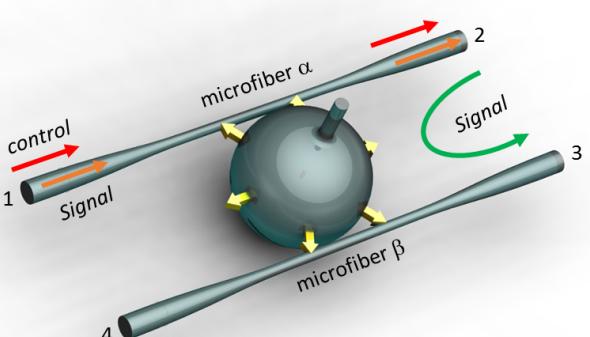8-MAY-2018
USTC Microcavity Research Group in the Key Laboratory of Quantum Information have perfected a 4-port all-optically controlled non-reciprocal multifunctional photonic device based on a magnetic-field-free optomechanical resonator is demonstrated for the first time. This achievement is published online in Nature Communicationson May 4.
Light has bidirectional transmission reciprocity in common dielectric material. Breaking this reciprocity in the direction of light transmission is of great significance in classical and quantum information processing. Optical circulators, isolators, directional amplifiers, etc. are typical non-reciprocal devices. Yet the most common optical non-reciprocal devices are based on the Faraday effects using magneto-optical materials, which are difficult to integrate on-chip. Therefore, in recent years, interest has increased in realizing on-chip all-optical non-reciprocal devices.
In 2016, DONG Chunhua's group experimentally demonstrated the optomechanically induced non-reciprocity in a whispering gallery mode microcavity [Nature Photonics 10, 657-661 (2016)]. On this basis, the group use a single cavity coupled with dual waveguides to implement a 4-part versatile photonic device, including the functions of narrow-band filter, four-port optical circulator and directional amplifier. The function mode can be switched arbitrarily by changing the control light.
For the circulator, the signal light incident from the ports 1, 2, 3 and 4, exits from the ports 2, 3, 4 and 1, respectively, constituting a 1-2-3-4-1 circular path. When only focusing on ports 1 and 2, it is also an efficient optical isolator; for directional amplifiers, signal light incident from port 1 is amplified and exits from port 2, not the other way around. Thus in the direction of 1-2 has directional amplification. The demonstrated device can even realize optical circulators with single-photon level and can be generalized to microwave and acoustic circuits.
###
SHEN Zhen, ZHANG Yanlei and CHEN Yuan are the co-first authors of this paper, with DONG Chunhua, ZOU Changling and SUN Fangwen as corresponding authors. The paper is funded by Ministry of Science and Technology, National Natural Science Foundation of China and Chinese Academy of Sciences.
The link of the paper: https://www.nature.com/articles/s41467-018-04187-8#Sec8
RELATED JOURNAL ARTICLE













